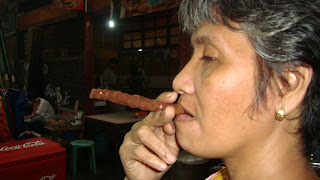This is chewed to extract the juice and spitted out.
The woman trying out an unlighted cigar.
Assorted native bags in different designs.
Handmade bags made of pandan leaves.
SUNGKA. A popular traditional local board game of calculation over skill which may have been brought by Indonesians when they migrated to the Philippines. Shells, pebbles, or seeds are used as tokens.

These colorful fans would come handy on a warm day.

Coconut husks used to scrub our wooden floors.

clay stoves

NIGO. Used as a food tray or basket when vending food or vegetables. This is carried on the head with a rolled cheesecloth as cushion.

KALALAW. A winnowing fan. Used to fan out the husks from the rice by raising the 'kalalaw' a little bit up in the air and the rice gets thrown up a bit. Usually done before cooking the rice.

Various ornamental handicrafts.

An assortment of hats made of pandan leaves and others.

This type of hat is called the 'salakot'. Worn by Filipinos in the 1800s. Now, these are mostly use as part of costumes, props or decors.

Welcome to the Dried Fish Section occupying the west sidewalk of the Central Market. There is a connotation that only people from the lowest income class eat dried fish.

Various types of 'balingon uga' using different sizes and types of fish.

This type of fish is called 'tabagak'.

Lucos. Dried squid. Best when deep fried.

sapsap

Danggit. filleted and dried.

Pinakas na gusaw. Filleted gusaw.

Balingon uga using 'gurayan' fish. Cooking procedure is pan fry it in little oil. Best when served with your favorite vinegar. Another cooking suggestion is as a salad. After pan frying it, add them to a bowl of cubed tomatoes and onions with vinegar and salt.

KALKAG. Dried baby shrimps. Suggested cooking procedure is to toast it on a hot pan. Best when peppered over your fried rice.

Dried fish is best served for breakfast. With fried rice and eggs. A truly Filipino breakfast.

Pickled mussels

peanut butter, piaya & kalamay hati

SHRIMP PASTE. Locally known as guinamos or bagoong in Tagalog. This is added to flavor some food recipes. Or it can be eaten as a side dish, when sauteed in lots of garlic and little vinegar. In some variation, pork fat is added.

IBUS. Glutinous rice soaked in coconut milk and wrapped in coconut leaves and cooked in boiling water. Eaten with some sugar preferably muscovado.
Comes in bundes of 5.

A lady vendor heaping the muscovado sugar into a neat mound.













 Fr. Mauricio Ferrero, the parish priest who started the construction of the San Sebastian Cathedral. He was also the one who built the road network South and North of Bacolod City.
Fr. Mauricio Ferrero, the parish priest who started the construction of the San Sebastian Cathedral. He was also the one who built the road network South and North of Bacolod City.



































